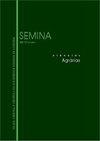Co-inoculation of Azospirillum with mycorrhizal fungi in the cultivation of wheat in soils contaminated with copper
IF 0.5
4区 农林科学
Q4 AGRICULTURE, MULTIDISCIPLINARY
引用次数: 1
Abstract
Copper is a micronutrient essential for plant growth since it is part of the constitution of enzymes and proteins. However, it can become toxic to plants when in high concentrations in the soil. The association between microorganisms and plants is an alternative for reducing the negative effects of excess copper on plants. The objective of this work was to determine the influence of inoculation and co-inoculation of arbuscular mycorrhizal fungi and Azospirillum brasilense in a wheat crop grown on soil contaminated with copper. The experimental design used was entirely randomized in a bifactorial arrangement of 5 x 2, with five sources of inocula, (Azospirillum brasilense; Acaulospora colombiana; Gigaspora margarita; Acaulospora colombiana + Azospirillum brasilense; Gigaspora margarita + Azospirillum brasilense;), two doses of copper (0 = natural soil content and 400 mg kg-1), and eight replicates. We evaluated the height of plants, number of tillers, root length, root volume, dry root mass, specific surface area, average root diameter, copper content in the root, straw and grain, productivity, and percentage of mycorrhizal colonization. The inoculation with A. brasilense increases the number of tillers, plant height, and productivity compared to mycorrhizal fungi. The co-inoculation of these microorganisms does not contribute positively to these evaluated parameters, regardless of the dose of Cu applied to the soil. Co-inoculation of A. brasilense with mycorrhizal fungi does not reduce copper in the aerial part of wheat plants, regardless of the evaluated species, even in soil contaminated with copper.氮螺旋菌与菌根真菌在铜污染土壤小麦栽培中的共接种研究
铜是植物生长所必需的微量元素,因为它是酶和蛋白质构成的一部分。然而,当土壤中的浓度很高时,它会对植物有毒。微生物与植物之间的联系是减少过量铜对植物的负面影响的另一种选择。研究了在铜污染土壤上接种和共接种丛枝菌根真菌和巴西偶氮螺旋菌对小麦生长的影响。试验设计采用5 × 2的双因子随机安排,采用5种接种源:巴西偶氮螺旋菌;Acaulospora动作片;Gigaspora玛格丽塔;哥伦比亚无孢子菌+巴西偶氮螺旋菌;(Gigaspora margarita + Azospirillum brasilense;),两剂铜(0 =天然土壤含量和400 mg kg-1), 8次重复。我们评估了植株高度、分蘖数、根长、根体积、干根质量、比表面积、平均根直径、根中铜含量、秸秆和籽粒、生产力和菌根定植百分比。与菌根真菌相比,接种巴西螺可增加分蘖数、株高和产量。无论施用于土壤的铜剂量如何,这些微生物的共接种对这些评价参数没有积极的贡献。即使在被铜污染的土壤中,巴西螺与菌根真菌共接种也不会减少小麦地上部分的铜含量。
本文章由计算机程序翻译,如有差异,请以英文原文为准。
求助全文
约1分钟内获得全文
求助全文
来源期刊

Semina-ciencias Agrarias
农林科学-农业综合
CiteScore
1.10
自引率
0.00%
发文量
148
审稿时长
3-6 weeks
期刊介绍:
The Journal Semina Ciencias Agrarias (Semina: Cien. Agrar.) is a quarterly publication promoting Science and Technology and is associated with the State University of Londrina. It publishes original and review articles, as well as case reports and communications in the field of Agricultural Sciences, Animal Sciences, Food Sciences and Veterinary Medicine.
 求助内容:
求助内容: 应助结果提醒方式:
应助结果提醒方式:


